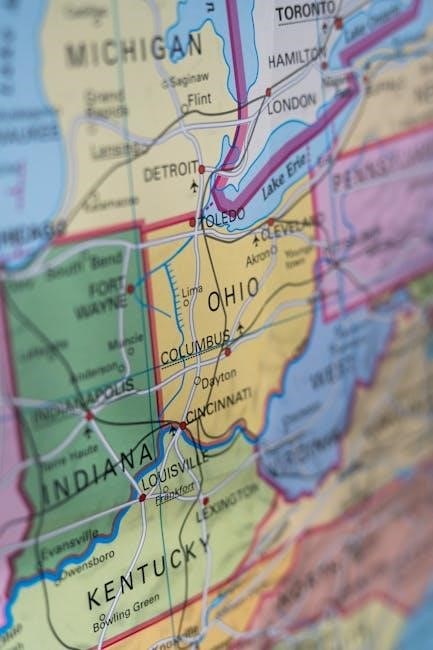
The Northeast Region of the United States includes New England and Mid-Atlantic states, known for diverse geography, rich history, and vibrant culture. It features iconic cities like New York and Boston, offering a blend of urban and natural landscapes. This guide explores its states, capitals, geography, economy, and cultural significance, providing a comprehensive overview for students and learners.
The Northeast Region of the United States is a vibrant and historically significant area located in the northern part of the Eastern Seaboard. Comprising nine states, including the New England states (Maine, New Hampshire, Vermont, Massachusetts, Rhode Island, and Connecticut) and the Mid-Atlantic states (New York, New Jersey, and Pennsylvania), this region is known for its rich history, diverse geography, and cultural importance. The Northeast is often referred to as the birthplace of America, as it was the site of early European colonization and played a pivotal role in the American Revolution.
The region is characterized by its bustling cities, such as New York City and Boston, which are hubs of finance, education, and culture. At the same time, it boasts stunning natural landscapes, including the Appalachian Mountains, the Atlantic coastline, and picturesque fall foliage. The Northeast is also home to some of the nation’s most prestigious universities and research institutions, making it a center for innovation and learning. This study guide provides an in-depth exploration of the Northeast Region, covering its states, geography, economy, and cultural significance, offering a comprehensive understanding of its role in shaping America’s identity.
States and Capitals
The Northeast Region of the United States comprises nine states, each with its own capital. The states in this region include Maine, New Hampshire, Vermont, Massachusetts, Rhode Island, Connecticut, New York, New Jersey, and Pennsylvania. Their respective capitals are Augusta, Concord, Montpelier, Boston, Providence, Hartford, Albany, Trenton, and Harrisburg. These states are divided into two sub-regions: New England (Maine, New Hampshire, Vermont, Massachusetts, Rhode Island, and Connecticut) and the Mid-Atlantic (New York, New Jersey, and Pennsylvania). Understanding the states and their capitals is essential for grasping the region’s political and geographical layout. This section provides a clear overview of each state and its capital, helping students memorize and identify them effectively.
- Maine ⎻ Augusta
- New Hampshire ⎻ Concord
- Vermont ― Montpelier
- Massachusetts ― Boston
- Rhode Island ⎻ Providence
- Connecticut ⎻ Hartford
- New York ⎻ Albany
- New Jersey ― Trenton
- Pennsylvania ― Harrisburg
This section serves as a foundational reference for studying the Northeast Region’s political divisions.
Geographical Features

The Northeast Region of the United States is characterized by a diverse and distinctive geography. It includes the Appalachian Mountains, which stretch through parts of New York and Pennsylvania, and the rugged terrain of New England, featuring mountains such as the White Mountains in New Hampshire. The region also boasts a scenic coastline along the Atlantic Ocean, with notable features like Cape Cod in Massachusetts and the Jersey Shore in New Jersey. Additionally, the Northeast is home to numerous rivers, including the Hudson, Delaware, and Connecticut Rivers, which have historically supported trade and settlement.
The region’s landscape is further defined by its dense forests, rolling hills, and fertile river valleys. These geographical features have played a significant role in shaping the region’s economy, culture, and history. The varied terrain also supports a wide range of ecosystems, from coastal wetlands to mountainous forests, making the Northeast a unique and ecologically rich area.
- Appalachian Mountains
- Atlantic Coastal Plain
- New England Highlands
- Major rivers (Hudson, Delaware, Connecticut)
- Coastal features (Cape Cod, Long Island Sound)
These geographical features contribute to the Northeast’s natural beauty and ecological diversity.
Climate
The Northeast Region experiences a humid continental climate, characterized by cold winters and warm, humid summers. Coastal areas, influenced by the Atlantic Ocean, tend to have milder temperatures compared to inland regions. Mountainous areas, such as the Appalachian Mountains and the White Mountains, often experience harsher winters with significant snowfall.
Seasonal variation is pronounced, with cold, snowy winters and warm, sometimes hot, summers. Spring and autumn are transitional seasons, with cool temperatures and rainfall. The region is also susceptible to extreme weather events, such as nor’easters, which can bring heavy snow and strong winds, and occasional hurricanes that affect coastal areas.
The climate supports a wide range of ecosystems, including dense forests and agricultural lands. The region’s climate contributes to its scenic beauty, particularly during autumn, when foliage attracts millions of visitors. However, it also poses challenges, such as snow removal in winter and managing the impacts of climate change.
- Cold, snowy winters
- Warm, humid summers
- Moderating influence of the Atlantic Ocean on coastal areas
- Extreme weather events (nor’easters, hurricanes)
- Scenic autumn foliage
The Northeast’s climate is a key factor in shaping its environment, economy, and daily life.
Economic Overview
The Northeast Region is a hub of economic activity, driven by diverse industries such as finance, education, healthcare, and technology. Major cities like New York and Boston serve as centers for global business and innovation. The region is home to some of the world’s most influential financial institutions, including Wall Street, and boasts a highly educated workforce.
Manufacturing plays a significant role, particularly in states like Massachusetts, where high-tech industries and precision manufacturing thrive. Agriculture is less prominent but contributes through products like maple syrup, dairy, and cranberries. Tourism is also a major economic driver, with visitors attracted to the region’s historical landmarks, cultural attractions, and natural beauty.
The Northeast is rich in natural resources, including forests and fisheries, which support logging and commercial fishing industries. However, the region faces challenges such as high living costs, urbanization pressures, and brain drain in rural areas. Efforts to diversify the economy and invest in renewable energy are underway to ensure sustainable growth.
- Finance and technology hubs
- Manufacturing and high-tech industries
- Tourism and cultural attractions
- Agriculture and natural resources
- Challenges of urbanization and high costs
The Northeast’s economy is a blend of tradition and innovation, shaping its role as a vital contributor to the U.S. economy.
Cultural Significance
The Northeast Region holds profound cultural significance, shaped by its rich history, diverse population, and vibrant arts scene. It is a melting pot of traditions, with influences from early European settlers, Indigenous communities, and modern immigration. The region is home to iconic historical sites, museums, and landmarks that reflect its pivotal role in American history, such as the Freedom Trail in Boston and Independence Hall in Philadelphia.
Culturally, the Northeast is renowned for its contributions to education, literature, and the arts. It boasts prestigious universities like Harvard and Yale, which have shaped intellectual and cultural movements. The region is also a hub for music, theater, and visual arts, with world-class institutions like the Boston Symphony Orchestra and the Museum of Modern Art in New York.
Festivals, fairs, and seasonal celebrations showcase the region’s unique identity, such as fall foliage events, maple syrup festivals, and maritime heritage celebrations. The Northeast’s culinary scene reflects its cultural diversity, featuring fresh seafood, farm-to-table cuisine, and ethnic dishes from around the world.
- Historical landmarks and museums
- Artistic and educational institutions
- Cultural festivals and traditions
- Diverse culinary influences
The Northeast’s cultural identity is a blend of history, innovation, and community, making it a cornerstone of American cultural heritage.
Transportation Infrastructure
The Northeast Region boasts one of the most developed transportation networks in the United States, serving as a critical hub for both domestic and international travel. Its infrastructure includes extensive roadways, railways, airports, and ports, facilitating the movement of people and goods.
The region is home to major highways like Interstate 95, which connects key cities such as Boston, New York, and Philadelphia. The rail network is equally robust, with Amtrak’s Northeast Corridor linking Boston to Washington, D.C., and offering high-speed rail services. This makes the Northeast a leader in passenger rail transportation.
Major airports, including John F. Kennedy International Airport (JFK) and Logan International Airport, handle millions of passengers annually, connecting the region to global destinations. Additionally, the Port of New York and New Jersey is one of the busiest seaports in the country, playing a vital role in trade.

Public transportation systems, such as the New York City Subway and Boston’s MBTA, provide efficient urban mobility. The region’s dense population and economic activity have driven the development of this comprehensive infrastructure, making it a cornerstone of its economic and social connectivity.

Education
The Northeast Region is renowned for its robust educational infrastructure, featuring some of the world’s most prestigious institutions. It is home to the Ivy League universities, including Harvard, Yale, and Princeton, which attract scholars and students globally. These institutions are celebrated for their academic excellence, research opportunities, and historical significance.
Beyond the Ivy League, the region boasts a multitude of top-tier colleges and universities, such as MIT, Boston University, and the University of Pennsylvania. These schools offer diverse programs in fields ranging from arts and humanities to science, technology, engineering, and mathematics (STEM). The concentration of these institutions in the Northeast fosters a vibrant academic environment.
Public education in the Northeast is also highly regarded, with many of its public schools ranking among the best in the nation. The region’s emphasis on education extends to its libraries, museums, and cultural organizations, which provide additional learning resources for both students and the general public. This strong educational foundation contributes significantly to the region’s intellectual and economic vitality.

Environmental Considerations
The Northeast Region faces unique environmental challenges due to its dense population and industrial history. Climate change impacts, such as rising sea levels and extreme weather events, pose significant threats to coastal areas, including cities like New York and Boston. These changes are altering ecosystems, affecting wildlife habitats, and increasing the risk of flooding in low-lying regions.
Conservation efforts are underway to protect the region’s natural resources. Initiatives focus on preserving forests, wetlands, and waterways, which are vital for biodiversity. States in the Northeast are also investing in renewable energy sources, such as wind and solar power, to reduce greenhouse gas emissions and promote sustainability.
However, historical industrial activities have left a legacy of pollution in some areas. Cleaning up contaminated sites and managing waste remain critical environmental priorities. Additionally, the region’s agricultural practices are being adapted to more sustainable methods to reduce the environmental impact of farming.
Overall, the Northeast Region is balancing economic development with environmental stewardship, striving to create a sustainable future while addressing its ecological challenges.
Tourism Highlights
The Northeast Region is a treasure trove of iconic landmarks, cultural richness, and natural beauty, making it a premier destination for tourists. From the bustling streets of New York City to the historic charm of Boston, visitors can explore world-class museums, theaters, and landmarks like the Statue of Liberty and Central Park. Philadelphia, with its Independence Hall and Liberty Bell, offers a glimpse into America’s revolutionary past.
The region’s fall foliage is renowned, with vibrant colors drawing millions to New England’s countryside. States like Vermont, New Hampshire, and Maine boast picturesque landscapes, perfect for hiking, skiing, and enjoying scenic drives. Coastal areas, such as Cape Cod and the beaches of New Jersey, provide relaxing getaways during the summer months.
Cultural attractions abound, with festivals celebrating local cuisine, music, and art. The region’s diverse history, from colonial times to industrial innovation, is preserved in numerous historical sites and museums. Whether exploring urban centers or escaping to nature, the Northeast offers something for every kind of traveler, making it a cornerstone of American tourism.
Government and Politics

The Northeast Region is characterized by a diverse and dynamic political landscape, with each state maintaining its own government structure. The region is known for its progressive political tendencies, with many states leading in areas such as social policy and environmental regulation. Local governments play a significant role in shaping community affairs, while state legislatures and governors address broader regional issues.
Federal representation is another key aspect, as the Northeast sends a substantial number of representatives to Congress, influencing national policy. Historically, the region has been a hub for political thought and activism, contributing to the development of American democracy. Today, it continues to be a battleground for debates on issues like healthcare, education, and economic development.
The region’s political diversity reflects its varied population and economic profiles, with urban centers like New York City and Boston often driving policy discussions. Despite challenges such as infrastructure needs and economic disparities, the Northeast remains a politically vibrant and influential part of the United States.
Demographics
The Northeast Region is one of the most densely populated areas in the United States, with a diverse demographic profile. The population is concentrated in urban centers, such as New York City, Boston, and Philadelphia, which serve as hubs for culture, economy, and education. The region is home to a mix of ethnic and racial groups, contributing to its cultural richness.
Historically, the Northeast has been a gateway for immigration, with significant populations of European, Asian, Hispanic, and African American communities. This diversity is reflected in the region’s languages, traditions, and cuisines. Urban areas tend to have higher population densities compared to rural parts of the region, which are more sparsely populated.
Age distribution in the Northeast varies, with older populations in some rural areas and younger, more dynamic populations in urban centers. Education levels are generally high, with numerous prestigious universities and colleges attracting students from across the country and internationally. These demographic factors contribute to the region’s vibrant economy and cultural landscape.
Historical Context
The Northeast Region is steeped in rich historical significance, playing a pivotal role in the development of the United States. It was home to many Native American tribes before European colonization, with groups like the Wampanoag and Iroquois inhabiting the area. The Pilgrims’ arrival in Plymouth, Massachusetts, in 1620 marked the beginning of European settlement, leading to the establishment of some of the nation’s earliest colonies.

The Northeast was a focal point during the American Revolution, with key events like the Boston Tea Party and the Battles of Lexington and Concord taking place in the region. The area’s historical legacy extends into the 19th century, when it became a hub for industrialization and immigration, shaping its cultural and economic identity.
Throughout the 20th century, the Northeast continued to evolve, contributing significantly to the nation’s progress in education, technology, and the arts. Its historical context is a testament to its enduring influence on American society and culture.
Agricultural Profile

The Northeast Region of the United States boasts a diverse agricultural profile, despite its challenging climate and limited arable land. The region is known for its production of fruits, vegetables, dairy products, and maple syrup. States like New York, Pennsylvania, and Vermont are prominent in dairy farming, contributing significantly to the nation’s milk and cheese production.
The Northeast is also a leader in organic farming, with many small-scale, family-owned farms prioritizing sustainable practices. Crops such as apples, cranberries, and blueberries are widely cultivated, with Massachusetts and New Jersey being major producers. Additionally, the region supports a thriving greenhouse industry, producing flowers, nursery plants, and leafy greens year-round.
Challenges such as a short growing season and cold winters have spurred innovation in agricultural techniques, including hydroponics and cold-storage technologies. Community-supported agriculture (CSA) programs are popular, connecting consumers directly with local farmers and fostering a strong sense of community. The Northeast’s agricultural sector plays a vital role in its economy and cultural identity, emphasizing local food systems and environmental stewardship.
Natural Resources Utilization
The Northeast Region is rich in natural resources, which have historically driven its economy and shaped its culture. Forests cover a significant portion of the region, providing timber for logging and wood products industries. States like Maine and New Hampshire are renowned for their dense forests, which also support recreational activities like hiking and hunting.
Water resources are another critical component, with numerous rivers, lakes, and coastal areas offering opportunities for fishing, hydroelectric power, and tourism. The region’s coastline along the Atlantic Ocean is vital for commercial fishing, with species like lobster, cod, and shellfish contributing to the local economy. Hydroelectric power plants along rivers such as the Connecticut and Hudson generate clean energy, reducing reliance on fossil fuels.
Mineral resources, including granite, marble, and sand, are extracted for construction and industrial purposes. Additionally, the region has seen growth in renewable energy projects, such as wind farms in Upstate New York and offshore wind initiatives along the coast. Sustainable practices are increasingly prioritized to balance economic needs with environmental preservation, ensuring the region’s natural resources remain abundant for future generations.
Challenges Facing the Region
The Northeast Region faces a range of challenges that impact its economic, environmental, and social development. One major issue is the decline of traditional industries such as manufacturing and fishing, which have historically been the backbone of the regional economy. This has led to job losses and economic instability in some areas. Additionally, the region struggles with an aging population and brain drain, as younger residents often migrate to other parts of the country in search of better opportunities.
Another significant challenge is the urban-rural divide, with cities like New York and Boston thriving while rural areas face limited resources and infrastructure. Climate change also poses a threat, particularly to coastal communities vulnerable to rising sea levels and extreme weather events. Environmental concerns, such as deforestation and pollution, further complicate the region’s ability to sustainably manage its natural resources. Addressing these challenges requires coordinated efforts from governments, businesses, and communities to ensure the Northeast Region remains resilient and prosperous.
Key Cities
The Northeast Region is home to some of the most iconic and influential cities in the United States. New York City, often referred to as the “City That Never Sleeps,” is a global hub for finance, culture, and entertainment. Boston, Massachusetts, is renowned for its historical significance, educational institutions, and vibrant arts scene. Philadelphia, Pennsylvania, is celebrated for its role in American history, including the signing of the Declaration of Independence. Pittsburgh, Pennsylvania, has transformed from a steel-industry powerhouse to a center for technology and healthcare. Buffalo, New York, is known for its architectural heritage and revitalization efforts along Lake Erie. These cities, along with others like Albany, Hartford, and Providence, play crucial roles in shaping the region’s economy, culture, and identity. Each city offers a unique blend of history, innovation, and community, contributing to the Northeast’s dynamic landscape.
Historical Significance

The Northeast Region holds profound historical significance as the birthplace of American democracy and culture. It was the site of the first successful European settlements, such as Plymouth Colony, where the Pilgrims landed in 1620. The region played a pivotal role in the American Revolution, with events like the Boston Tea Party and the signing of the Declaration of Independence in Philadelphia. Cities such as Boston, New York, and Philadelphia served as hubs for political and social change, shaping the nation’s early identity. The Underground Railroad, active in states like Pennsylvania and New York, highlights the region’s role in the fight against slavery. Additionally, the Northeast was a cornerstone of the Industrial Revolution, with innovations like the first railroad and textile mills driving economic growth. Its rich history is preserved in landmarks such as Independence Hall, the Freedom Trail, and the Erie Canal, which transformed the region into a vital trade corridor. The Northeast’s historical legacy continues to influence its culture, education, and economy, making it a cornerstone of American heritage.
Educational Resources
The Northeast Region is renowned for its robust educational resources, catering to learners of all levels. The region is home to some of the world’s most prestigious universities, such as Harvard, MIT, and Yale, which offer unparalleled academic and research opportunities. Additionally, institutions like the Boston Public Library and the New York Public Library provide extensive access to historical archives, educational materials, and digital tools. For K-12 students, resources like the Northeast Regional Education Service Center offer professional development for educators and curriculum support. Online platforms such as Khan Academy and Coursera also provide accessible learning opportunities for residents. Museums and cultural centers, such as the American Museum of Natural History and the Smithsonian affiliate museums, serve as interactive learning spaces. The region’s commitment to education is further evident in its numerous public and private libraries, which host workshops, lectures, and community programs. These resources collectively foster a culture of lifelong learning, making the Northeast a hub for intellectual growth and development. The abundance of educational resources ensures that students and educators alike have access to the tools needed for success.

Practice and Assessment
Mastering the Northeast Region requires effective practice and assessment tools. Utilize printable study guides, online quizzes, and interactive maps to reinforce knowledge of states, capitals, and geographical features. Websites like Study.com and educational platforms offer practice tests and flashcards tailored to the Northeast Region. Engage with digital tools such as Kahoot! and Quizlet to test knowledge in a competitive and engaging way. For hands-on learning, worksheets and activity sheets are available, focusing on mapping skills and state/capital matching. Assess progress with graded tests and track improvement over time. Additionally, educational apps like Duolingo and National Geographic Kids provide interactive exercises. Many schools incorporate regional studies into their curriculum, offering practice materials and assessments aligned with learning objectives. Regular practice ensures a strong grasp of the Northeast Region’s unique characteristics. These resources are designed to make learning fun and effective, helping students achieve academic success. By using these tools, learners can confidently navigate the complexities of the Northeast Region’s geography, history, and culture.
The Northeast Region of the United States is a vibrant and historically rich area, offering a unique blend of culture, geography, and economic significance. Through this study guide, learners have explored the region’s diverse states, capitals, and geographical features, as well as its climate, economy, and cultural importance. Key cities, historical contexts, and educational resources have been highlighted, providing a comprehensive understanding of the Northeast. The region’s challenges and opportunities, such as environmental considerations and tourism highlights, have also been addressed. By engaging with practice materials and assessments, students can solidify their knowledge and apply it in real-world contexts; This guide serves as a valuable resource for anyone seeking to understand the Northeast Region’s role in shaping the United States. Whether for academic purposes or personal enrichment, this study guide equips learners with the essential knowledge needed to appreciate the Northeast’s enduring significance.